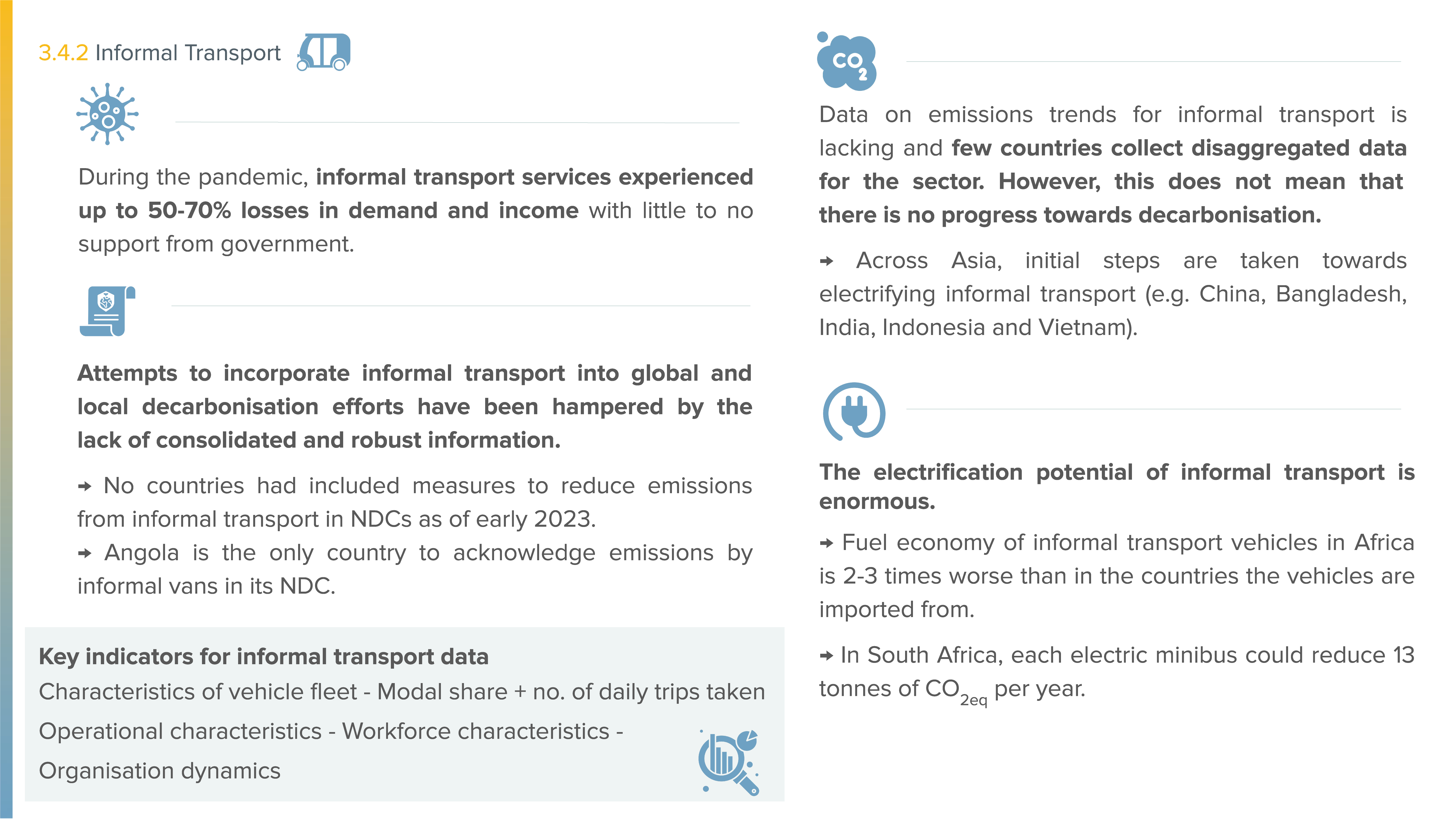-
Informal Transport
- Key Findings
- Informal transport services are among the most common urban mobility systems globally. They are present in nearly every city and town in low- and middle-income countries and even in the underserved fringes of cities in high-income countries.
- Informal transport refers to services that are offered with some measure of informality in their operations, not planned or operated by governments. These services tend to be demand-driven, unscheduled, and flexible, reflecting varying degrees of organisation among drivers and operators.
- If integrated into policy and planning, informal transport could help to accelerate the transition towards more sustainable transport systems worldwide.
- A tendency to ignore or eliminate informal transport, despite its immense contributions, has generated large gaps in policy, knowledge and data.
Demand trends
- Global data on the size, reach and ridership of informal transport fleets are lacking, although research is attempting to close this knowledge gap. Overall, the market share for these services is high, especially in Sub-Saharan Africa and in some Latin American cities, while it is lower in Asian cities.
- Electrification efforts for two- and three-wheelers, which are major modes for informal transport, are accelerating rapidly. However, there is little information on how much of the informal fleet is electrified. Most sales of electric two- and three-wheelers are in Asia (especially in China, India and Vietnam), and the vehicles are projected to continue to be the largest electrified road transport fleet globally.
- During the COVID-19 pandemic, informal transport experienced up to 50-70% losses in demand and income between 2020 and 2022, depending on the region, with little to no support from government. These services also were essential to ensure that riders had access to transport, particularly in vehicles that allowed for greater ventilation and lower capacity, such as bike taxis, two- and three-wheelers, and pick-up trucks.
- In some African cities, up to 95% of all motorised trips are made using informal transport.
- The vehicles (and names) used for informal transport services typically vary by region. Minibuses appear to be the most-used mode in Africa and in Latin America and the Caribbean, whereas two- and three-wheelers are most common in Asia.
- By 2022, Africa was home to 27 million registered two- and three-wheelers, of which 80% were used for passenger transport and/or delivery services; this was up from less than 5 million in 2010.
- In certain Latin American cities, fleets of minibuses and collective taxis are similar in size to or even larger than government-provided bus fleets.
- Informal transport can also be found in high-income countries, although to a far lesser extent. When such services are linked to the use of technology or digital platforms, they either are part of government-supported pilots or services, or are quickly regulated under categories such as app-based mobility, demand-responsive transport, ride-hailing or mobility-as-a-service.
Emission trends
- In general, data on emission trends for informal transport are lacking, and few countries collect disaggregated data for the sector. However, this does not mean that there is no progress towards decarbonisation.
- Angola is the only country in the world to acknowledge the emissions caused by informal vans in its Nationally Determined Contribution (NDC) towards reducing emissions under the Paris Agreement.
- A study found that the fuel economy of vehicles used for informal transport in Africa is two to three times worse than in the countries the vehicles are imported from.
- The potential to electrify informal transport is enormous: in South Africa, each electric minibus in operation could reduce tailpipe emissions by 13 tonnes of carbon dioxide (CO2) equivalent annually.
- The available information on emissions from informal transport in Asia focuses mainly on specific vehicle types. Across the region, initial steps are being made towards electrifying informal transport.
- In Latin America, efforts to calculate emissions from informal transport or to electrify these modes remain scarce, although some examples exist.
Policy developments
- The most common policy measures and innovations are mapping, digitalisation and the introduction of technological platforms to improve the experience of users and service providers. Less common, but very relevant efforts include organisational and financial support to reform the sector in certain cities.
- As of early 2023, no countries worldwide had included measures to reduce emissions from informal transport in their NDCs under the Paris Agreement.
- Attempts to adequately incorporate the informal transport sector into global and local decarbonisation efforts have been hampered by the lack of consolidated and robust information.
Authors: Andrea San Gil León and Adriana Quesada Valverde, Global Network for Popular Transportation



